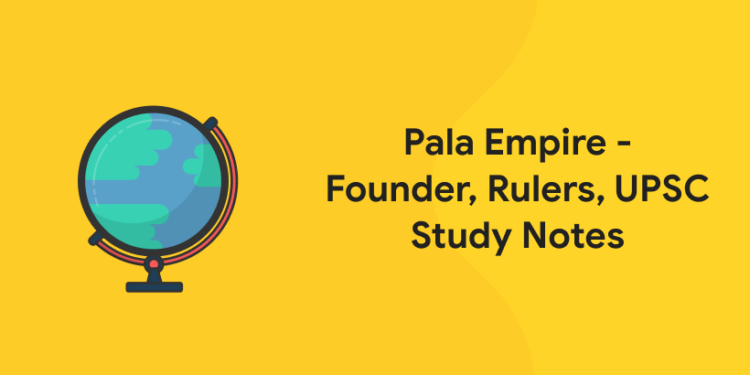Table of Contents
After the death of Harshavardhana, many kingdoms emerged in North and Eastern India. After the decline of the Gauda King Shashanka, there was dispute in the region forming Bengal. The Pala kingdom had a close relationship with Southeast Asia particularly the Sri Vijaya Empire in Sumatra. It also had links with the Tibetan Empire and the Arab Abbasid Caliphate.
Pala Empire: Origin
- The Pala Empire was founded by Gopala in the 8th century.
- The Empire has been named ‘Pala’ as the rulers of this Empire had a suffix added to their names ‘Pala’, which means – protector in Sanskrit language.
- The Pala Empire started its rule in the states of Bihar and Bengal but the boundaries / the ruled areas of the Pala dynasty kept changing often due to various falls and revivals of the kingdom.
- Gopala conquered the throne as the first emperor as the Bengal region was in a state of revolution after the fall of the Shashanka’s kingdom, and lack of any central authority to manage the state.
- There were about 20 rulers of the Pala dynasty who ruled for 400 years.
- The Pala Empire is regarded as the ‘Golden era’ in the history of Bengal.
- Many kingdoms had come into power in Northern and Eastern India after the death of Harshvardhana.
Attempt Free GK Test! Download Entri App!
Soon after the downfall of the Gauda King Shashanka, there came lawlessness in the northern and the eastern regions of the country which gave an opportunity to the Palas to take over the control and set the foundation of the Pala Empire.
Grab Latest Study Materials! Register Here!
Rulers of Pala Empire
1: Which Year First Assembly Election was held in Kerala?
Gopala (750–770 AD)
- Gopala was the founder of the Pala dynasty and the first emperor of the dynasty. He was the son of Vapaata, who was a warrior.
- Gopala is charged of having killed the queen Naga, who had consumed all the kings before the night of the election and captured the throne.
- He is assumed to have not been elected by the group of people directly, but by a group of chieftains.
- Gopala had built the monastery at Odantapuri situated in Bihar. He is also considered to be the first (1st) Buddhist king of Bengal.
- At the time of Gopala’s death, the Pala dynasty had almost captured most of Bihar and Bengal.
Dharmapala (770–810 AD)
- Dharmapala was the son and successor of Gopala under whom the kingdom had expanded considerably and is considered to be a pious Buddhist.
- Dharmapala had a range of wars with the Pratiharas and the Rashtrakutas.
- Under Dharampala’s rule, the Palas got a lot of power and became the most powerful empire in the Northern and the Eastern part of India.
- Dharmapala also set the foundation of Vikramshila University in Bhagalpur in the state of Bihar.
Grab Latest Study Materials! Register Here!
Devapala (810–850 AD)
- Devpala was the son of Dharampal and Rannadevi, who was the princess of the Rashtrakuta kingdom.
- Devpala had expanded the kingdom to eastern India in the states of Assam, Odisha and Kamarupa.
- He had built many monasteries including temples in Magadha as he was a loyal Buddhist.
- He had defeated Amoghavarsha, who was the ruler of the Rashtrakuta kingdom.
Mahipala I
- Ascended the throne in 988 AD.
- Recovered northern and eastern Bengal.
- Also took Bihar.
Ramapala
- The last strong Pala king.
- The kingdom disintegrated during his son Kumarapala’s reign.
Grab Latest Study Materials! Register Here!
Madanapala (Reign: 1144 – 1162 AD)
- After him, the Sena dynasty replaced the Palas.
- The 18th ruler of Pala dynasty and general considered the last ruler but he was succeeded by Govindapala who lineage of this name is questionable.
Enroll in Kerala's Top-rated Kerala PSC Coaching Program!
സർക്കാർ ജോലി എന്ന സ്വപ്നം ഇനി സ്വപ്നം മാത്രമല്ല! Join Entri's Kerala PSC Coaching Programs
Join Now!Legacy of the Pala Dynasty
- The Pala Empire was displaced by the Hindu Sena dynasty in the 12th century.
- The Pala period is also known as a ‘Golden Era’ in Bengali history.
- They constructed spectacular monasteries and temples: Somapura Mahavihara (in Bangladesh), Odantapuri Monastery.
- They also patronised Buddhist centres of learning like Nalanda University and the Vikramshila University.
- During this time, the Bengali language developed. The first Bengali literary work Charyapada is assigned to this era. It was written in an Abahatta (the common ancestor of Bengali, Assamese, Odia and Maithili).
- Balaputradeva, the Sailendra king of Java sent an ambassador to Devapala.
- Buddhist poet Vajradatta who composed Lokesvarashataka was in Devapala’s court.
- Many Buddhist teachers from the Pala kingdom travelled to Southeast Asia to spread the faith. Atisha preached in Sumatra and Tibet.
- Sanskrit scholars were also patronised by the Pala kings. Gaudapada composed Agama Shastra during the time of the Palas.
- The Pala art (art seen in Bengal and Bihar during the Pala regime) influence is seen in the art of Nepal, Sri Lanka, Burma and Java.
Practise free mock test and ace your government exams! Download Entri App!
Pala Empire: First Decline
- Soon after the death of Devpala, the Pala Dynasty saw a huge fall in the empire.
- Devpala’s nephew, Vigrahapala who had failed to undertake the throne after a short rule became frugal after that.
- After Vigrahapala, the throne was overtaken by his son Narayanapala, who then proved to be even weaker ruler as it was during his (Narayanapala) rule, the Rashtrakuta ruler Amoghavarsha had conquered the Palas.
- After Narayanapala, his son Rajyapala had overtaken the throne and ruled for about 12 years.
- During his rule, he constructed various utilities for the public and huge temples.
- After that, Gopala II, son of Rajyapala ruled the empire and under his rule, the Pala empire had lost Bengal in a few years.
- Gopala II now had the rule over Bihar only.
- After Gopala II, the throne was handed over to Vigrahapala II, who faced various invasions from the Chandelas and the Kalachuris.
- After this, the Pala kingdom had been broken down to further smaller kingdoms which consisted Gauda, Anga, Radha and Vanga.
Grab Latest Study Materials! Register Here!
Pala Empire: Revival
Mahipala I
- Mahipala I got into the throne in 988 AD.
- It was under Mahipala I’s rule when the Pala empire began its revival and again achieved the Northern and the Eastern parts of Bengal and Bihar.
- Mahipala I’s son, Nayapala had defeated the then ruler of Kalachuri – Kama.
- Both the parties had then agreed to sign a peace treaty in the meditation center of the Buddhist scholar Atisa.
- When Nayapala’s son, Vigrahapala III overtook the throne, Kama tried to conquer Bengal again but no use.
- Both the parties again signed a peace treaty followed by the marriage of Kama’s daughter with Vigrahapala III.
- Vigrahapala III lost his battle to Chalukya kingVikramaditya VI.
- Under Vigrahapala III, the Pala dynasty also lost the rule of Odisha which had then reduced the power of the Palas considerably. Mahipala I is also said to have conquered Varanasi, as there were various construction and renovation of sacred structures and temples along with his brothers – Stirapala and Vasantapala.
Grab Latest Study Materials! Register Here!
Enroll in Kerala's Top-rated Kerala PSC Coaching Program!
സർക്കാർ ജോലി എന്ന സ്വപ്നം ഇനി സ്വപ്നം മാത്രമല്ല! Join Entri's Kerala PSC Coaching Programs
Join Now!Pala Empire: Second Revival
Rampala
- It was under Rampala’s rule when the Pala Dynasty began to acquire power again.
- Rampala had begun to rule the empire from the new capital of the empire – Ramavati, which also remained as the capital of the kingdom until the Pala dynasty broke down completely.
- Rampala had worked hard to gain control over Orissa, against the Ganga king.
- Rampala had kept a friendly relation with Kulottunga, the Chola king for the support against the common enemies of both the empires – Gangas and Chalukyas.
- Rapala is regarded as the last Strong leader/ruler of the Pala dynasty.












